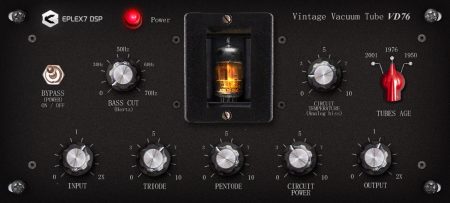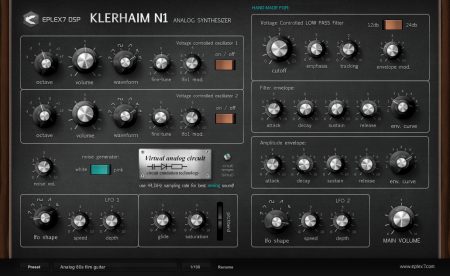Description
Eplex7 DSP Equelectrium EQA-1 – VST plugin equalizer

There are many digital / plugin equalizers on the market. Why do we need another one?
This is a brand-new technology and style of equalization, with totally different sound results.
Our short article about the philosophy behind Equelectrium EQA-1 and Sectio aurea EQing technology. Please read.
Compared to real analog equalizers, most of digital EQs produces harsh digital sound when boosting – sharp, unpleasant, digital sounding transients and trebles, harshness, squared bass, artifacts instead of color, etc.
Usually, you can hear it better (or only) after mastering at high volume levels. (You can do test of equalizers by putting the EQ on master channel or equalizing complex audio material mixed from many channels together, and putting a limiter after it at commercial level like -8RMS.)
After mastering / limiting your track will probably sound harsh and unpleasant on transients and trebles if you use boosting of digital eqs in your mix – you can hear it best on a high quality hi-fi system or loud PA system in a club.
You think the problem lies in your mixing skills – maybe too much limiting, compression etc. which cause distortion and artifacts, right?
Yes, maybe, but surprisingly most problems are usually caused by digital equalizers and by too much boosting of various EQ frequencies (mostly mids and trebles). Why?
Because digital equalizers work on different principles than analog ones.
While an analog equalizer works with a real electric signal, a digital EQ is boosted just by numbers and performs digital calculations. This causes various problems with the sound and the sound becomes digital and unnatural. After discussions with many experienced mixing and mastering engineers + our own experiences we realized that source of harsh unpleasant sounding mixes is mostly equalizer not just dynamic processors.
To be honest, most digital emulations of analog machines are often just marketing illusions and produce more dirt and digital artifacts than real analog sound in the digital domain. If you use it many times on many channels, these digital problems / artifacts are counted together and amplified during mastering at high volume levels.
After more than 17 years of constructing analog audio devices and coding DSP software, we accidentally got the idea for a new way of equalization. To help you understand it better, we would like to introduce you to the philosophy behind it.
When you look at the universe, the world or physics in detail, you may recognize that many systems in the universe work on similar principles and patterns. They have exact physical laws. After reading books of George Soros, who is a highly educated modern philosopher (not just a stock trader as many people think), we realized that many systems in nature, in society and not only in economy work on the principles of “imaginary” so-called equilibrium.
For better understanding, allow us to present a few easy examples:
In nature, when the temperature in summer becomes too high, “systems” in nature create colder wind and or storm / rain to “stabilize” the temperature in normal levels – equilibrium. This is caused by physical law. Cold air moves to place where hot air is and replace it. When the temperature of air is hotter, then more steam accumulates in the atmosphere, and more clouds are created – denser clouds = bigger chance of rain. The temperature of this place is colder within few hours. When the temperature of the air is too high, usually a strong storm is coming, hotter weather = stronger storm. When we increase the global temperature too much through CO2 emissions, etc. more and more anomalies can be recorded as more tornadoes, extreme temperature swings, prolonged drought, heavy rain etc. It can be noticed by charts. The average world temperature is growing just a little but the “volatility” of temperatures (hot / cold swings) is growing and swinging more. This means that nature tries to find balance (equilibrium) in many complex systems.
Our body works on similar principles. While the outer temperature is often in the range from -10 to +37 Celsius degree, our inner temperature remains in equilibrium usually from 35,8 °C to 37 °C. This is regulated and stabilized by many mechanisms inside our body (heating and cooling mechanisms) and similar mechanisms with the pH of the blood, which must be between 7,36 and 7,44 otherwise, you may die.
Similar systems also work also in the economy. When markets go into an irrational overpriced bubble, far above the level of the imaginary equilibrium, usually the system / bubble bursts and creates an inverted extreme – economic recession, which has a stabilizing effect. Because overpriced assets / markets also create instability – like too much public loans, that may be defaulted in the future, extreme prices of properties, unemployment rates so low that it becomes difficult to find people who would like to work hard and seriously etc.). After some time, the “system” returns from recession to a normal state – imaginary equilibrium. George Soros described this behavior also in social establishments and systems like communism, which were far out of balance for decades and then cracked and caused revolutions. Simply put, moving any system too far above its supposed equilibrium (normal state), either up or down, creates instability – also in music/mixing!
As one of the best philosophers of all time, who was searching for the secrets / principles of life and the universe, Siddhartha Gautama, known as Buddha, said: “Always try to find the golden middle way” in everything. More extremes we create = The more extremes we create, the more problems and instability arise as a result.
Famous mastering engineer Bob K. says in his book: “If you must equalize a record during mastering more than (if we remember correctly 3-4 dB) it must be remixed again. You should sent it back to the mixing studio because it creates too much instability / disharmony in the overall sound”.
Another important “pattern” in nature / the universe is the Fibonacci number or Fibonacci sequence (also known as the Golden Ratio – Sectio Aurea) Fibonacci sequences appear in many biological settings, such as the branching of trees, the arrangement of leaves on a stem, the fruitlets of pineapples, the flowering of artichokes, the uncurling ferns and the arrangement of pine cones and the family tree of honeybees.
Johannes Kepler pointed out the presence of the Fibonacci sequence in nature and used it to explain the (golden ratio-related) pentagonal form of some flowers. Field daisies most often have petals in counts of Fibonacci numbers. In 1754, Charles Bonnet discovered that the spiral phyllotaxis of plants were frequently expressed in Fibonacci number series.
The Golden ratio technique has been used in art, photography, architectur,e and music because it seems to be the most natural for our brain.
For example, photography composed according to the Golden ratio law is perceived as the most aesthetically pleasing by people. It is decoded by our brains as the most natural composition, probably because it is closest to the natural patterns in nature / the universe).
Inspired by this knowledge, we began experimenting with various new kind of algorithms.
After a long time, we created a brand-new DSP technique that draws from the theory of equilibrium and Fibonacci / Sectio Aurea, both in frequency and amplitude domains.
This algorithm significantly removes disharmony across the entire frequency range caused by equalization. It eliminates digital harshness – ugly digital transients and trebles – while the sound is boosting. The sound is more natural, trebles are softer, less digital, transients are natural not sharp and artificial, bass is fat and round, similar to analog hardware equalization.
We also integrated many algorithms simulating real analog circuits, based on our 17+ years of experiences with analog electronics and emulation of circuits / components in DSP.
Various methods of analog emulation were used, from capturing hardware to digital simulation of electronic circuits and components.
You probably don’t hear a significant difference from one EQ to another until the record is mastered at high volume levels. This is where problems like harsh trebles, digital artifacts, and ugly transients are boosted 5-10x in mastering or when you use EQ on just one channel, like drums, synth or piano. However, problems accumulate when inferior equalizer is used on 8-20 individual mixer channels and then mastered. You’re probably thinking why my mix / master doesn’t sound as good, so sweet, natural, and pleasant on good hi-fi or in the club.
Try removing all equalizers (and other mix processors) from the mix.
Use just the EQUELECTRIUM EQA-1 plugin equalizer on every mixer channel (and master stereo bus if needed). Perform mastering and compare the significant difference on a high quality hi-fi system like Bowers & Wilkins, Tannoy, KEF, PMC etc. (not classic near-field monitors, which usually do not translate high frequencies, color, and transients well because are designed for long work to remove ear fatigue).
Do not worry about your mixes. Do not spend tens of hours or weeks on them while they still sounding digital, harsh and unpleasant.
Try new technologies and more comfortable ways.
TOP FEATURES:
– Game changing Sectio Aurea / Equelectrium technology of Equalization inspired by Fibonnaci / Golden ratio and system of equilibrium in nature. (Please read description and philosophy of development above) which removing almost all ills of classic digital eqs (and digital analog emulations) audible when eq is boosting like: harsh trebles, digital artifacts, sharp artificial digital sounding transients, squared bass etc. and imbalance in mix.
– Realistic emulation of analog circuits and components using various techniques from capturing real hardware to virtual circuits technology (based on our 17+ years of experiences with constructing own analog hardware and DSP coding, see Eplex7 DSP analog labs)
Equelectrium EQA-1simulates sound of solid state (transistor based) analog hardware equalizers and its color. Transistor based EQs / hardware has precise, less colored sound.
– High frequency air band (high shelf with more Baxandall type analog curve) from 8 to 19kHz, from classic analog treble to precise high frequency air – with clean detailed trebles and transients without unwanted harshness and artifacts
– Bass frequency band from 40 to 350 Hz, with fat round analog style bass
– Mid range frequency – band pass filter with frequency range based on frequency of bass and high frequency circuit. From 40 to 19 kHz with intensive warm analog solid state sound.
– Cut / attenuate circuit with adjustable frequency from 70 Hz to 8 kHz, from sharp to wide Q (bandwidth) control and cut from 0 to 10db. Very clean and “creamy” sounding cut inspired by passive filters.
– 2nd Cut / attenuate circuit with adjustable frequency from 350 Hz to 19 kHz, from sharp to wide Q (bandwidth) control and cut from 0 to 10db. Very clean and “creamy” sounding cut inspired by passive filters.
– Input knob to control level of input knob (and also amount of color – louder signal = more analog color and saturation mainly when analog drive knob is activated – turned right)
– Analog drive knob – To add analog hardware warmth of transistor based hardware with transformers from very gentle color and saturation to more intensive saturation, warmth + softening and rounding of trebles / transients caused mainly by isolation coil transformers in analog machines.
– Output knob to adjust output volume
– Preset manager: Only available in full version (settings are reset after every use / opening of project in DEMO version!)
TRY DEMO VERSION BEFORE PURCHASING:

———————————————————————–
BUY NOW & SUPPORT NEXT DEVELOPMENT, THANK YOU!
Here is what you get if you purchase FULL VERSION:
+6000 Plus GOOD KARMA Points (instead of -10000 minus Karma points if use pirated software 🙂
– Lifetime updates!
– Full version without any restrictions, with special wishes and registered to your name
– Preset manager
NOTE: We manually generate full files within 24 hours of PayPal / Stripe transaction confirmation. Thanks for your patience. If you didn’t received download link after 36 h, please contact us.
BEFORE PURCHASE: We require you to download the demo plugin and try a compatibility with your DAW. All demos here.
———————————————————————–
ARTISTS / TESTIMONIALS:
from music producers
“…I inserted it on to vocal track and I loved it. I don’t need it for anything else…Saving to template.”
(analag – Gearspace member since 2019)
“…Actually it’s some kind of clean eq if Analog Drive is on 0. The first impression is good, looks like I will use it.”
(edvo – Gearspace member since 2022)
“Thank you for this amazing EQ!”
(Florian W. – Eplex7 customer)
———————————————————————–
BUY NOW & SUPPORT NEXT DEVELOPMENT, THANK YOU!
Here is what you get if you purchase FULL VERSION:
+6000 Plus GOOD KARMA Points (instead of -10000 minus Karma points if use pirated software 🙂
– Lifetime updates!
– Full version without any restrictions, with special wishes and registered to your name
– Preset manager
NOTE: We manually generate full files within 24 hours of PayPal / Stripe transaction confirmation. Thanks for your patience. If you didn’t received download link after 36 h, please contact us.
BEFORE PURCHASE: We require you to download the demo plugin and try a compatibility with your DAW. All demos here.





